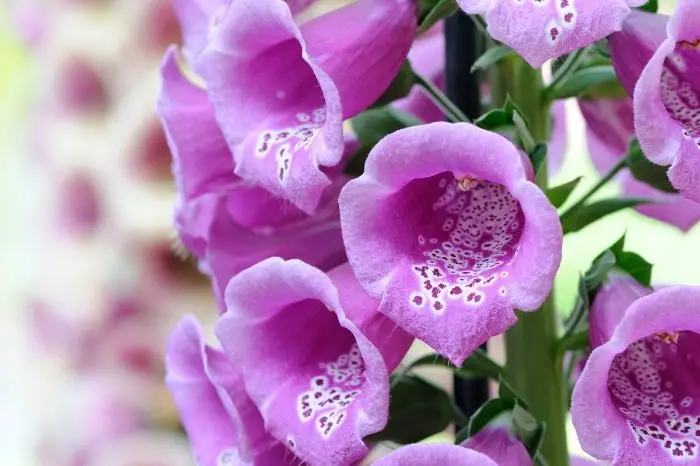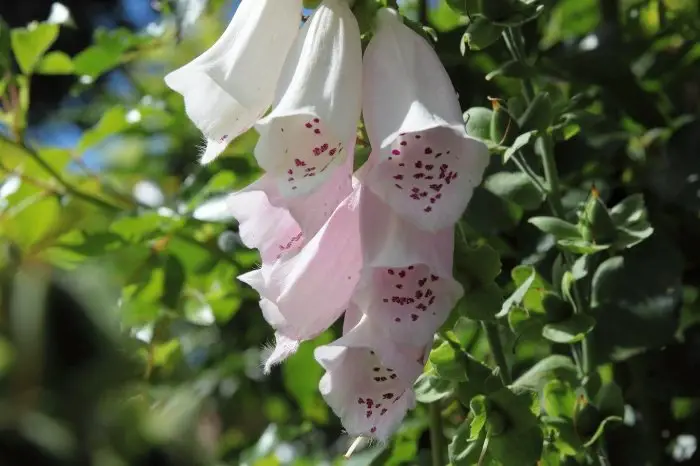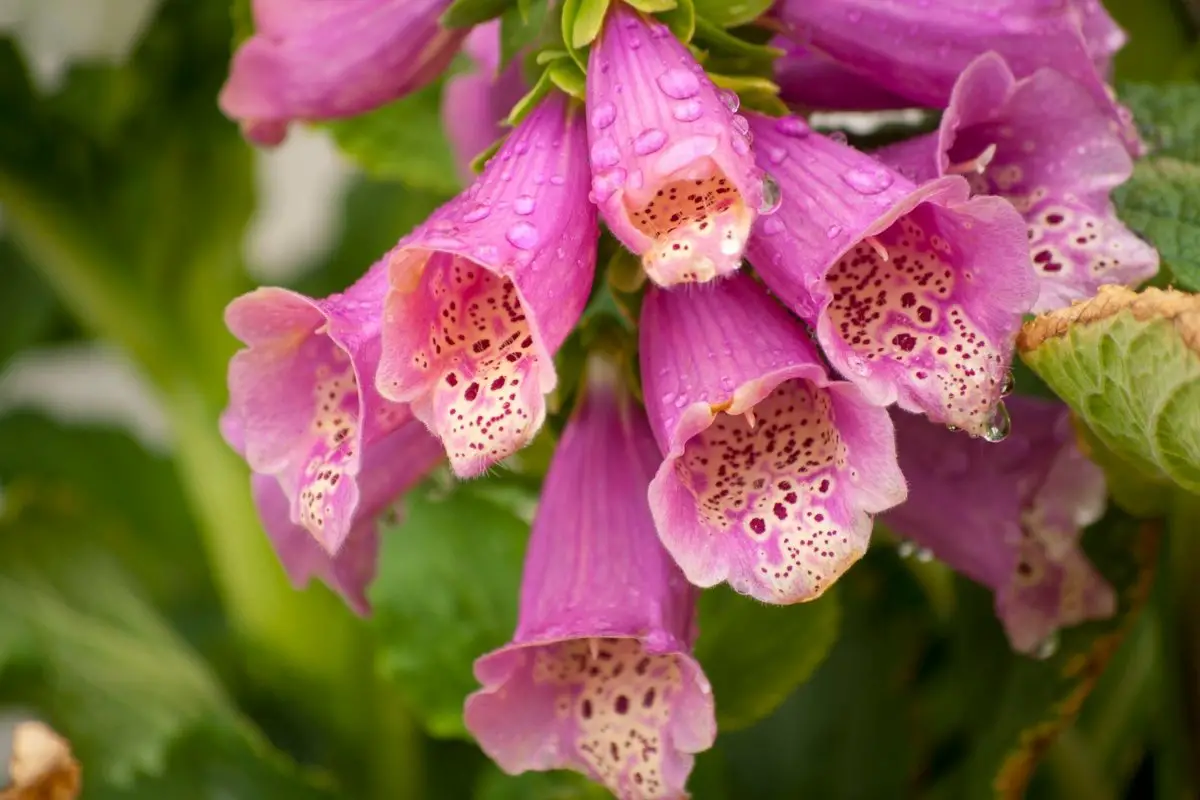Last Updated on May 7, 2022 by Griselda M.
Mother nature often disguises dangerous plants into mesmerizing blooms, so if you’re wondering is foxglove poisonous, the answer is yes. Gardeners cultivate this plant for its fascinating flowers, but you can also find it growing independently in nature. The term foxglove covers 20 species from the Digitalis genus. Today we’ll take a closer look at the common foxglove.
The toxicity of the plant is not a myth. The plant needs to be handled cautiously and grown only if you don’t have kids and pets around. Unlike other plants with one specific toxic part, the whole foxglove is a threat to your health.
How much is foxglove poisonous? We dive into the subject below.
What Is Foxglove?
Foxglove is a perennial plant that is native to Europe and North Africa. It’s not native to the US; it was introduced to North America from Europe. It’s considered invasive in the western parts of the US.
This plant can be grown from seed or purchased from a garden center. However, many beginner gardeners aren’t aware that most cultivars of this plant bloom in their second year. They need to mature before they form their first flowers.
The foxglove grows up to 5 feet tall and 2 feet wide. The tall stem is covered in clusters of trumpet-shaped flowers. It needs staking to keep the stem upwards and prevent bending.
The common foxglove has 7 popular cultivars in different colors, from rosy pink to white with red specks. The colorful blooms will have you rethinking how is foxglove poisonous?
Read more about 9 Amazing Spanish Flowers Names
Foxglove’s Natural Habitat
Is foxglove poisonous as an attempt to protect itself? Like thousands of other plants, the foxglove has evolved into a heavily toxic plant to defend itself from herbivores. It’s often used as a hedgerow plant and grows naturally in fields, wooded areas, and clearings.
The foxglove needs cooler temperatures, slightly acidic soil, and benefits from partial shade. It thrives in USDA zones 4 to 10. But it won’t react well to temperatures over 90°F and full sun. If you live in a warmer and humid climate but want to grow foxglove, pick a shaded spot for it.
When it comes to watering, the foxglove is drought tolerant to a certain level. You should water it using a soaker house during summer instead of pouring water from above. It’s very susceptible to fungal diseases and root rot.
Seed Needs, Gloxiniaeflora Foxglove (Digitalis purpurea) Twin Pack
The Story Behind The Name
There are two theories on how this plant got its name. The first one is connected to a 16th-century botanical scientist whose surname translates to Fox. Combined with the flower’s look, it resulted in fox’s glove.
The second theory dates from the Anglo-Saxon period when people referred to the plant as Foxes glofa. The translation is fox’s glove.
Click Here to Learn About:
How Is Foxglove Poisonous
So what part of foxglove is poisonous? The plant contains deslanoside, digitoxin, and digitalis glycoside. These chemicals cause poisoning, heart attacks, or death. Poisoning occurs when you ingest some part of the plant, whether it is a flower, leaf, seeds, stem, or root.
The foxglove is not poisonous to the touch, but you can absorb trace amounts of the chemicals through the skin. Therefore, you need to use gloves when handling any part of the plant.
Foxglove Can Kill Humans
Wondering how much foxglove is poisonous? In January of 2021, a man in Ireland ingested just two plant leaves. This resulted in dangerously slow heart rate and kidney injury.
Is foxglove poisonous if ingested as medicine? Foxglove is used to make the prescription drug digoxin. For a long time, doctors used this medicine to treat heart problems. However, today, other medications have higher success and fewer side effects.

The digoxin is administered under close monitoring by a doctor and given in extreme cases as it can cause cardiovascular failure and irregular heartbeat.
Symptoms Of Foxglove Poisoning
If you experimented without checking if foxglove poisonous, you might experience some of the following symptoms:
- low blood pressure;
- dizziness and confusion
- blurred vision
- hallucinations
- loss of appetite and stomach pain
- lethargy or depression.
If you or someone you know has ingested foxglove, contact a medical care provider urgently. Do not administer any medicine until you reach a doctor. In some cases, it takes up to 3 days to get better. But there are also more severe cases that require weeks of hospitalization.
Check Out Decorative Plant Lights You Can Use Indoors
Removing Foxglove From Your Garden
So which part of foxglove is poisonous? All of it, even the sap and the pollen! If you have pets and children or edible plants nearby, it’s best to remove the foxglove from your garden.
- Put on your gloves and a face mask to prevent skin contact or inhaling some of the toxic parts. Prepare a bag too.
- Place the bag under the plant and cut it to the ground. If the plant is mature, there might be seeds that can fall to the ground and grow again.
- Dig out the roots and discard them in the bag. Look around for younger foxglove plants. The seeds fall off and germinate on their own.
- Throw away the bag and check for new foxgloves around the same spot every few weeks.
- Wondering is foxglove poisonous when dried? Yes, so don’t add it to your compost!

Bottom Line: Is Foxglove Poisonous?
Common foxglove is a biennial or perennial plant that can be grown from seeds or both from a garden center as a mature plant. If you wondered is foxglove poisonous, it is due to the chemicals contained in all parts of the plant.
If you have kids, pets, or a vegetable garden, it’s best to remove any foxglove plants. Use gloves when handling the plant, and don’t ever ingest any parts.
FAQ’s
What part of foxglove is poisonous?
All parts of the foxglove plant, including the roots, stems, flowers, leaves, sap, and pollen, are poisonous. Small amounts of the toxins can penetrate your skin after prolonged exposure, so you should wear gloves when gardening.
How much foxglove is poisonous?
Two grams of fresh foxglove or 5 grams of dried leaves can dangerously affect an adult's health. Much less is needed for kids and pets. The younger foxglove plants have a higher concentration of toxic chemicals.
How is foxglove poisonous?
Foxglove is poisonous due to the number of cardiac glycosides. In fact, they're extracted and used in medicine to help people with cardiovascular issues. However, the cardiac glycosides can cause heart attack and even death when ingested via the plant.
Mary is a passionate gardener who loves spending her days getting her hands dirty and nurturing her plants. She‘s an avid reader of gardening magazines and is always looking for new ways to make her garden thrive. When not outside tending to her plants, Mary can be found inside reading up on the latest gardening trends, comparing notes with fellow gardeners, and finding the perfect pottery planter for her next planting project.



